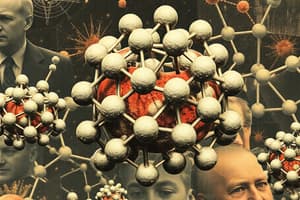Podcast
Questions and Answers
What is the most stable type of fullerene?
What is the most stable type of fullerene?
- C30
- C70
- C60 (correct)
- C90
Which of the following is a potential use of buckyballs in medicine?
Which of the following is a potential use of buckyballs in medicine?
- Improving medical imaging (correct)
- Serving as a vitamin supplement
- Creating artificial organs
- Acting as a source of energy
Which structural feature is characteristic of fullerenes?
Which structural feature is characteristic of fullerenes?
- Solid carbon blocks
- Hollow balls made of carbon (correct)
- Layered carbon sheets
- Strands of carbon fibers
How many hexagonal and pentagonal phases does a fullerene like C60 contain?
How many hexagonal and pentagonal phases does a fullerene like C60 contain?
What is a potential risk of using gadolinium in medical imaging?
What is a potential risk of using gadolinium in medical imaging?
What characteristic bond length is associated with carbon-carbon bonds in fullerenes?
What characteristic bond length is associated with carbon-carbon bonds in fullerenes?
Which of the following uses of fullerenes is related to their chemical properties?
Which of the following uses of fullerenes is related to their chemical properties?
In drug delivery, what property of buckyballs aids their effectiveness?
In drug delivery, what property of buckyballs aids their effectiveness?
Flashcards
Fullerenes
Fullerenes
Spherical or cage-like carbon allotropes, including C60 and C70; a crystalline form of carbon.
C60 fullerene
C60 fullerene
The most stable type of fullerene, a hollow sphere of carbon atoms.
Carbon allotrope
Carbon allotrope
Different structural forms of an element, carbon in this case.
Buckyball use in medicine
Buckyball use in medicine
Signup and view all the flashcards
Medical imaging with buckyballs
Medical imaging with buckyballs
Signup and view all the flashcards
Drug delivery with buckyballs
Drug delivery with buckyballs
Signup and view all the flashcards
Buckyball applications
Buckyball applications
Signup and view all the flashcards
Fullerenes as conductors
Fullerenes as conductors
Signup and view all the flashcards
Study Notes
Introduction to Fullerenes
- Fullerenes belong to the carbon family, the third allotrope of carbon.
- They are hollow cages, with carbon atoms interconnected in pentagonal and hexagonal rings.
- A fullerene is a pure carbon molecule, C60 being the smallest.
- The most famous fullerene is C60, also known as a buckyball.
- Fullerenes are extensively used in biomedical applications including MRI contrast agents, X-ray imaging contrast agents, photodynamic therapy, and drug/gene delivery.
Brief History of Fullerenes
- In 1985, Sir Harold Kroto, Richard Smalley, and Robert Curl discovered fullerenes.
- They vaporized graphite rods in a helium gas atmosphere using a pulsed laser.
- The structure of fullerenes was theorized to be like a soccer ball.
- C60 was named "buckminsterfullerene," in honor of Buckminster Fuller, and the shortened name "fullerene" refers to all fullerenes
- In 1996, Curl, Kroto, and Smalley received the Nobel Prize in Chemistry for their discovery.
Importance of Geodesic Domes
- Geodesic domes are a strong and durable architectural form, able to withstand extreme weather conditions.
- Versatile, with applications in diverse areas like residential, commercial, industrial buildings, also greenhouses and temporary shelters.
- Energy efficient, needing less heating and cooling compared to traditional buildings.
Synthesis of Fullerenes
- Kratschmer-Huffman Method: Graphite electrodes are vaporized using restrictive heating in a helium atmosphere. The resulting soot can be extracted with benzene. Modified by Smalley using an electric arc.
- Combustion Process: Fullerenes are produced in sooting flames through a premixed benzene-oxygen-argon mix under low pressure.
Types of Fullerenes
- Buckyball clusters
- Nanotubes
- Megatubes
- Polymers
- Nano"onions".
- Linked "ball-and-chain" dimers
- Fullerene Rings
Properties of Fullerenes: Chemical Reactivity
- Aromatic, but C60 is non-aromatic.
- Insoluble in polar solvents, soluble in aromatic solvents and carbon disulfide.
- High electron affinity and chemically reactive, especially with free radicals
- Rapid decomposition in presence of trace amounts of ozone.
- In pure oxygen, C60 sublimes at 350°C and ignites at 365°C, rapidly oxidizing to CO and CO2.
- Catalyzes the oxidation of H2S to sulfur.
Physical Properties of Fullerenes
- Insoluble in water
- Cannot conduct electricity
- Soft and slippery
- Brittle
- Low melting point
Applications of Fullerenes: Medicinal
- Antioxidant
- Antimicrobial agents
- Drug delivery
- Photosensitizers in photodynamic therapy
Other Applications of Fullerenes
- Personal care products
- Dry lubricants
- Solar cells
- Hydrogen gas storage
- Strengthening/hardening metals
- Sensors
- Molecular wires
- Organic photovoltaics (OPV)
- Catalysts
- Water purification/biohazard protection
- Bulletproof vents
Conclusion
- This study provides a basis for understanding fullerene structure, properties, and applications in science and technology.
- Due to useful properties, fullerenes are key in nanotechnology and industrial research.
- Fullerenes are widely used in drug and cosmetics industry, mainly as antioxidants.
Studying That Suits You
Use AI to generate personalized quizzes and flashcards to suit your learning preferences.




